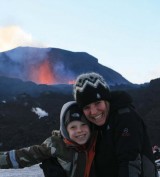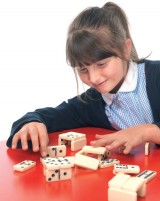Introduce your class to the colossal forces of nature unleashed by volcanoes and earthquakes with these handson activities from the IPC...
Sleeping bags line the school dining hall, black and yellow tape cordons off an unsafe area – it’s late at night but children and teachers with torches are checking the building for damage. A whistle sounds and there’s frantic activity to save a missing child who has been trapped by fallen bricks. It sounds like a disaster, but it’s not – children from Y3 and Y4 at Chestnuts Primary School are taking part in their ‘entry point’ for the Active Planet learning unit from the International Primary Curriculum (IPC).
“It completely transformed their learning,” says deputy headteacher at Chestnuts, Allison Collis, describing the impact that a night at a mocked-up disaster relief centre in the school building had on the children. “They referred back to the whole experience constantly throughout the unit. It made it real, relevant and exciting for every one of them – and for the staff!”
The entry point is an event that takes place at the beginning of every IPC learning unit to immediately engage the children and establish a common experience that all the children can draw on throughout several weeks of thematic learning. Each unit then goes into a series of subject learning tasks all linked to the theme, with each task flexible enough to meet the interests and the specific needs of every child.
“The Active Planet was an excellent unit, especially for focusing on science and geography knowledge and skills,” says Allison. “But links were made with all the foundation subjects, and it was great for providing relevant links for literacy too. The unit also allowed us to focus on the human impact of earthquakes, volcanoes and tsunamis, enabling the children to apply personal skills such as empathy and cooperation.”
The unit is designed to work best when subject learning is delivered in blocks, meaning that children spend several days on a discrete subject linked to the theme before moving on to several days of another subject. What follows is a look at some of the geography learning tasks that the children from Chestnuts Primary enjoyed with the volcanoes and earthquakes-themed unit.
The children began their learning by discussing as a class and researching individually what volcanoes look like, exploring the different states of a volcano and finding out what can happen when one erupts. They also looked at where volcanoes can be found, marking their locations on a large map on the wall.
In groups, the children’s next task was to research a volcano of their choice – for instance a historical volcano like Vesuvius in Pompeii. They had to discover key pieces of information such as the volcano’s current status, details of any past volcanic activity, the location of any local towns that might be affected by an eruption and whether they thought any future activity would be likely.
 Each group went on to present this information to the rest of the class using visual aids and ICT to support their findings. “The children explored these questions and many more at home on the internet and through our virtual learning platform,” says Allison. “We put all the questions onto a forum and they had online chats about what they’d discovered.”
Each group went on to present this information to the rest of the class using visual aids and ICT to support their findings. “The children explored these questions and many more at home on the internet and through our virtual learning platform,” says Allison. “We put all the questions onto a forum and they had online chats about what they’d discovered.”
Combining science and geography learning, the children next created a detailed model of a volcano out of clay, identifying the different parts in cross section, and then performed a simple science experiment using sodium bicarbonate and vinegar to produce carbon dioxide to simulate a volcanic eruption.
What you’ll need:
• Vinegar
• A plastic bottle
• Sodium bicarbonate
• Sand and gravel
• A large dish or tray
• A funnel
• Red food colouring
• Flour
1. Mix flour and sodium bicarbonate; then use the funnel to half fill the bottle with the mixture. Stand the bottle upright in the tray, and pile sand and gravel around it to make a cone. Mix vinegar and food colouring to make a strong red colour. Use the funnel to add the red vinegar to the bottle.
2. Remove the funnel and watch for the eruption!
The children observed the reaction and discussed afterwards how accurate a representation of an eruption it provided, before writing up their work and creating labelled diagrams to explain what they did.
“The children loved making the volcano erupt,” says Allison. “It was one of many learning activities that the children, particularly those who like hands-on learning, really benefited from.”
Learning about the significance of fault lines and tectonic plates was a key area of the children’s Volcanoes and Earthquakes unit. One of the learning tasks focused on helping children to develop an understanding of the latter.
After researching where the Earth’s plates meet with the aid of atlases and other reference books, the children used an enlarged map of the world, backed with thin card, to mark and then cut along the lines of the tectonic plates. Using this model, the children were then able to learn what happens when the plates move apart or against each other.
The children then marked the locations of major earthquakes and volcanoes, looking for similarities and differences, and attempted to come up with explanations for what they had discovered.
A great example of active learning was the creation of a seismograph. In the IPC learning task, children make their own seismograph and then use it for recording tremors and movement.
What you’ll need:
• A cardboard box (without a lid)
• A felt-tip pen
• Sticky tape
• A pencil
• Modelling clay
• String
• A piece of card
1. Take a cardboard box without a lid – the open part of the box will be the front of the seismograph. Make a hole in the top of the box and then roll clay around the felt-tip pen to weight it. Tie one end of some string around the top of the pen and thread the other end through the hole in the box. Once it’s through, tie it around the middle of a pencil.
2. Next, roll the string round the pencil so that the tip of the pen just touches the bottom of the box, and tape the pencil onto the top of the box. Put the card in the bottom of the box so that the pen tip can just mark it. Shake or tilt the box and the pen will mark the card, creating a seismograph.
 3. Children can test their seismograph using different types of movement – try placing them in a moving car, holding them whilst walking smoothly or placing them on a trolley that’s being pushed along. The children can then take their findings and divide the different activities into their own ‘Richter Scale’.
3. Children can test their seismograph using different types of movement – try placing them in a moving car, holding them whilst walking smoothly or placing them on a trolley that’s being pushed along. The children can then take their findings and divide the different activities into their own ‘Richter Scale’.
Having learnt about the nature of the Earth’s movement, the children went on to learn about how an earthquake actually releases this energy. For this task the children built model houses using building blocks or dominoes and playing cards for a roof, positioning their model near the edge of a table. Then they gently hit the opposite edge of the table with their hand and watched for any effect. They repeated the same activity, gently hitting the edge of the table closest to the house. This helped the children to learn about they way that earthquakes release energy in the form of waves travelling through the ground. (Children can video this task and then play it back in slow motion to best see their results.) “The children really benefited from this activity because they were able to see how it happens,” says Allison. “Videos are good to watch but they don’t always help children to understand how something occurs.”
 These were just some of the geography-based activities the children got stuck into. Over the course of the unit the children also looked at countries that suffer earthquakes and have responded by developing ‘earthquake-proof’ buildings, e.g. Japan. Having examined what these building are like, what they’re made of and what happens to them in the event of seismic activity, children even tried constructing their own quake-proof structures.
These were just some of the geography-based activities the children got stuck into. Over the course of the unit the children also looked at countries that suffer earthquakes and have responded by developing ‘earthquake-proof’ buildings, e.g. Japan. Having examined what these building are like, what they’re made of and what happens to them in the event of seismic activity, children even tried constructing their own quake-proof structures.
Notably, it wasn’t just the children of Chesnuts Primary who were enthused by their learning with the Active Planet. “The parents were really excited about the sleepover Entry Point and what the children were learning as a result,” says Allison. “It’s things like this that are making all the difference to our parental involvement. The children are wanting to continue with their learning at home and this has brought the parents on-board.”
The International Primary Curriculum is the fastest growing independently-owned primary curriculum in the world today and is considered by many educationalists to be the most internationally-minded and learning-focused curriculum available for primary children. It is now the curriculum choice of over 690 primary schools in England and Wales who join schools in 61 countries around the world learning through the IPC.
To visit an IPC school in your area call the IPC on 020 7531 9696 or visit http://www.internationalprimarycurriculum.com
Should you let educational researchers into your classroom?
Ace-Classroom-Support
How to use Harry Potter to engage high-ability learners
Ace-Languages
